#indian and arabic spices
Text
On at least one occasion, Matt has woken up, wandered into the kitchen like the ghost of a Victorian child, flicked on the lights and had a minor crisis. He's picking everything up and squinting at it because he can't read anything. How many rips did he take off the bong he can't remember getting out last night? Then he finally wakes up enough to realize he's not brain-damaged or baked, it's just all in Ukrainian and Polish because Katya did the shopping last. And he can read it.
#katya and matt || the soil of our souls#matthew || my country is winter#katya || бо лишало на серці сліди#This post is brought to you by the fact I have Ukrainian loved ones#and I can't read half the fucking products in my kitchen rn#because a new polish store opened up nearby#canadian household these days is like#slavic groceries#french health and beauty and taiwanese bubble tea#japanese crockery muah love you muji#british condiments#indian and arabic spices#taiwanese stationary
34 notes
·
View notes
Photo

Spaniards and Portuguese in India and the Malay Archipelago, 1498-1580.
“Historical atlas”, William Shepherd, University of London Press, 3rd ed. 1924
by cartesdhistoire
Muslim merchants from Gujarat, based in Cambay, dominated maritime trade in the Indian Ocean in the 15th century, supported by Hindu and Jain financiers and an organized network of correspondents. The Malabar coast, a major pepper supplier, served as a hub for commercial interactions between Arab merchants from the Gulf of Aden or Oman and Chinese merchants – or their intermediaries – from Sumatra and Malacca. Muslim merchants primarily engaged in the spice trade.
The arrival of Vasco da Gama in Calicut in 1498 disrupted this system. In 1502, King Manuel entrusted him with commanding a second expedition aimed at eliminating all Muslim presence in the Indian Ocean. The Sultans of Gujarat and the Deccan sought assistance from a Mamluk fleet to counter the Portuguese, but it was defeated before Diu in 1509, paving the way for Portuguese conquests of Goa in 1510, Malacca in 1511, Hormuz in 1515, Diu in 1535, and Daman in 1539.
The Portuguese occupied the southwest coast of Ceylon from 1505 to access cinnamon, establishing a fort in Colombo in 1518. They controlled the north, west, and south coasts of the island, key areas for the cinnamon and precious stone trade.
The Moluccas were another target because the Banda Islands produced nutmeg, while Ternate and Tidore produced cloves. The Portuguese established privileged relations with the sultans of Ternate and Tidore, facilitating their settlement in Amboyna and Timor, despite the capture of Malacca from Sultan Mahmoud Shah.
The Portuguese monopoly endured until the emergence of the English East India Company and the Battle of Swally in 1612.
Meanwhile, Spain remained engaged in the spice race, aiming to connect America to the Moluccas and their spices. Following expeditions in 1525 (Loayza) and 1528 (Saavedra), Spain secured a definitive return route in 1565 (Urdaneta) and established settlements in the Philippines in 1571.
90 notes
·
View notes
Text
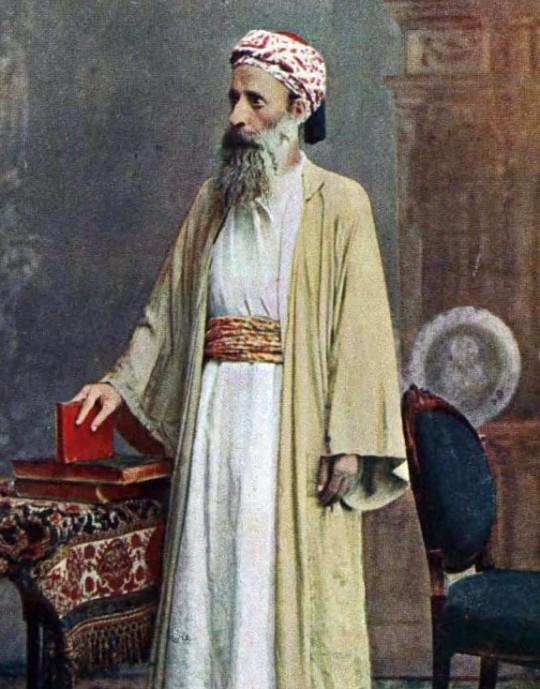
Baghdadi Jewish rabbi from India, late 19th century
The Persian Gulf port of Basra began to serve as a trading center in the 18th century. It was from there and other nearby cities that many Jews who played an important role in British commerce in the region gradually moved on to Mughal India. In the 1780s, hundreds of Jews from Aleppo, Baghdad and Basra made up the Jewish colony in the west coast port of Surat. Later the community thrived in the cities of Mumbai and Kolkata, making their fortune in cotton, jute, tobacco processing and opium trades. They adhered to the Judeo-Arab religious and social customs, which were strongly influenced by Islamic tradition. Middle Eastern dishes like the Koobe (stuffed dumplings) remain popular among the Baghdadi Jews, who have also incorporated Indian spices and tropical vegetables into their cuisine.
92 notes
·
View notes
Photo
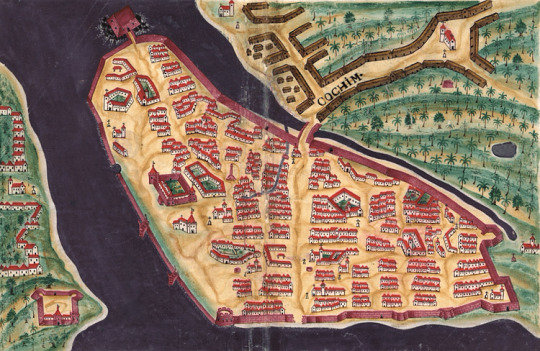
Portuguese Cochin
Cochin, located on the southwest coast of India, was a Portuguese colony from 1503 to 1663. Known to the Portuguese as Cochim, it was one of several important cities on India’s Malabar Coast and a great trade centre for spices like pepper. Cochin was the administrative capital of Portuguese India until it was replaced by Goa in 1530.
A fort was built at Cochin in 1503, the first in Portuguese India, as the Europeans used the city as their first headquarters in the East. The great explorer Vasco da Gama (c. 1469-1524) spent his last days in the city, and it remained a lucrative hub of the spice trade into the 17th century. The city was taken over by the Dutch in 1663, then the English in 1814, and finally gained independence with the rest of India in 1947. Today, the city is known as Kochi and is the most prosperous port in the Kerala region of India.
Vasco da Gama
In the 15th century, the Portuguese colonization of Madeira in the North Atlantic from 1420 was the first in a series of colonial stepping stones that eventually led to India. The treacherous Cape Bojador in West Africa was negotiated in 1434, the Azores were colonised from 1439, Cape Verde from 1462, and São Tomé and Principe from 1486. In 1488 Bartolomeu Dias sailed down the coast of West Africa and made the first voyage around the Cape of Good Hope, the southern tip of the African continent (now South Africa).
The famed Portuguese explorer Vasco da Gama followed in Dias’ wake and pioneered a maritime route from Portugal to India when in 1497-9, he sailed around the Cape of Good Hope, went up the coast of East Africa, and crossed the Indian Ocean to arrive at Calicut (now Kozhikode) on the south-west coast of India. His voyage, supported by King Manuel I of Portugal (r. 1495-1521), was intended to find a legendary Christian kingdom in the East and to give Portugal direct access to the Eastern spice trade and cut out the Arab middlemen traders. The first aim ended up being an illusion but the second was indeed achieved. For the first time, Europe could access by sea a trade which had been going on for centuries but which channelled luxury goods through the Red Sea and the Persian Gulf to be then taken by camel caravan to the Mediterranean. Such goods as pepper, ginger, cloves, and cinnamon were immensely popular in Europe and expensive.
Vasco da Gama, through a mix of inexperience, lack of trade goods, and Indian confidence in the status quo, failed to establish friendly trading relations with Calicut. A second Portuguese expedition, this time with 13 ships and 1500 men and commanded by Pedro Álvares Cabral, set off to repeat da Gama’s feat in March 1500 and was given the brief of muscling-in on Muslim trade by sinking any Arab ships they came across. Vasco da Gama sailed for a second time to India in 1502-3, this time with 15 ships. A result of this voyage was more trouble with the ruler of Calicut, but a trade treaty was agreed with Cochin further down the coast.
Continue reading...
25 notes
·
View notes
Note
i would totally be in Scarabia
only because I would cry if i was in Heartslabyul or Pomefiore
they are very english and have not much in the way of spices
and jamie oliver uses chili jam
urk i still shiver when i think of that
the other reason would be that i am very used to 35 degree celsius and above weather and if i had to go to anywhere under 26 degrees i would shrivel up and die
(is jamie oliver supposed to be jamil....aslkajsfjk)
I did forget that Europe was a thing, as well as forgot that Heartslabyul and Pomefiore would be European. My seasonings…noooooooooooooo
My original answer still stands, personality-wise I match up best with Pomefiore but I think I'd be a good match in Scarabia too. I do wonder what their food would be. Aladdin is a weird mash of Arabic and Indian cultures, I think, so it's not as easy to assign a real world equivalent to Scalding Sands like the others. I think food wise at least, Jamil's favorite food is closer to Indian cuisine (there's like several ethnic/regions in India too tho soooo). Kalim likes coconut juice, but that's not native to either India or Arabic countries. I think… I forgot what this ask was originally about.
#mochi asks#twst#twisted wonderland#jamil viper#kalim al asim#im very passionate about food specifically can you tell
34 notes
·
View notes
Text
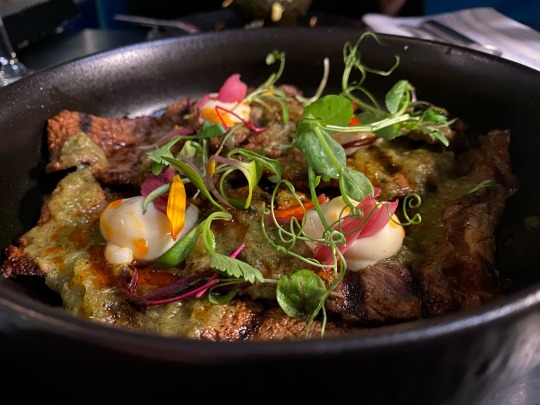
A beef appetizer that melts in your mouth in a combination of Indian and Arabic spices for a mouthwatering fusion of flavor - courtesy of farzi
#food#foodgasm#foodporn#yum#eating#nomnom#foodblogger#eatinglove#delicious#eatingfun#foodiemccaterson#sexy#moist#beef#succulents#succulent#spicy
13 notes
·
View notes
Text
Population: 16,000
The submitter commented “Historic trading town in Zanzibar, used to trade spice and unfortunately en-slaved people. Freddie Mercury was born here! It is also architecturally fascinating as it has Arab, Persian, Indian and European influences (this can also be seen in their food culture); these factors is why it was designated as a UNESCO heritage city. The beaches are also wonderful (but watch out for sea urchins owie!) and the people are really friendly (especially when you ask about food influences and what dishes they really enjoy!). I highly recommend visiting at some point if you are able to travel there!”
8 notes
·
View notes
Text
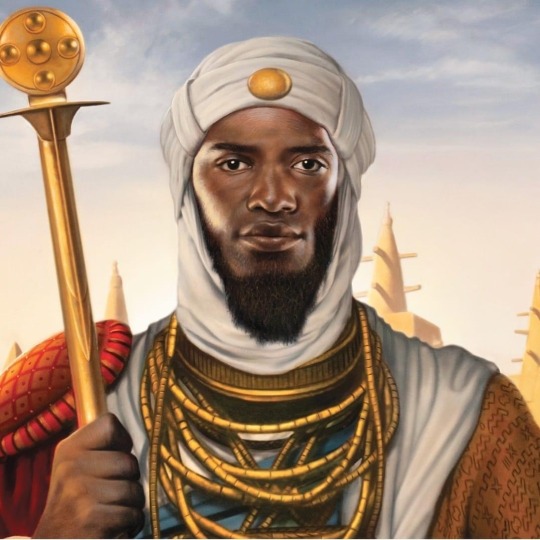
White people ask, why has there never been a powerful African nation like Rome, Persia, or the Aztecs?
Wait, seriously? “Never been a powerful African nation," says who exactly?
I’d presume you’ve never heard of some of these before:
ZULU KINGDOM. They crushed the British in their first battle and wrecked havoc on the Boers.The Zulu Kingdom, sometimes referred to as the Zulu Empire or the Kingdom of Zululand, was a monarchy in Southern Africa that extended along the coast of the Indian Ocean from the Tugela River in the south to Pongola River in the north.
MALIAN EMPIRE. Home to one of the richest Kings in human history. The Mali Empire was an empire in West Africa from c. 1226 to 1670. The empire was founded by Sundiata Keita and became renowned for the wealth of its rulers, especially Mansa Musa. The Manding languages were spoken in the empire.
KINGDOM OF AXUM. One of the centers of African civilization centuries before any European civilization. The Kingdom of Aksum, also known as the Kingdom of Axum or the Aksumite Empire, was a kingdom centered in Northeast Africa and South Arabia from Classical antiquity to the Middle Ages.
ANCIENT EGYPT. One of the centers of civilization. The civilization of ancient Egypt began in the Nile River valley of northeastern Africa. Ancient Egypt was one of the world's first civilizations. It is also one of the most famous civilizations in history.
KINGDOM OF KUSH. Which has more pyramids than Egypt by the way. The Kingdom of Kush was an ancient kingdom in Nubia, centered along the Nile Valley in what is now northern Sudan and southern Egypt. The region of Nubia was an early cradle of civilization, producing several complex societies that engaged in trade and industry.
THE KINGDOM OF DAHOMEY - This was a West African kingdom located within present-day Benin that existed from approximately 1600 until 1904.
THE KINGDOM OF BENIN - Also known as the Edo Kingdom, or the Benin Empire was a kingdom within what is now southern Nigeria. It has no historical relation to the modern republic of Benin, which was known as Dahomey from the 17th century until 1975.
THE GHANAIAN EMPIRE - Also known as Wagadou (Arabic: غانا) or Awkar, was a West African empire based in the modern-day southeast of Mauritania and western Mali that existed from c. 300 until c. 1100. The Empire was founded by the Soninke people, and was based in the capital city of Koumbi Saleh.
KONGO KINGDOM. Prior to the Portuguese arrival, Kongo was developed with a large commercial network. The kingdom melted copper and gold and traded it with products such as raffia cloth and pottery. The kingdom was a superpower and center of trade routes for ivory, copper, raffia cloth, and pottery.
ASHANTI EMPIRE. One of the most powerful and wealthiest states of the 18th-19th century.
The Asante Empire, today commonly called the Ashanti Empire, was an Akan state that lasted between 1701 to 1901, in what is now modern-day Ghana. It expanded from the Ashanti Region to include most of Ghana as well as parts of Ivory Coast and Togo.
The various African Kingdoms and empires were quite well known in Imperial Persia. The Sassanid & Nubian Kings in particular were quite familiar with each other. In fact, Persian traders and travelers extensively traveled the coastlines of modern-day East & North Africa bringing back various cuisines, spices, technologies, and in certain instances; slaves and laborers. Many Africans who came to Iran even became highly skilled soldiers and commanders in the Imperial Sassanid Army.
Moors is a term generally used by Europeans to describe the Muslim people of North Africa and the Iberian Peninsula during the Middle Ages. Between 711 C.E. and 1492 C.E. Muslim people of African descent controlled parts of Iberia which consist of modern-day Spain and Portugal, they ruled and civilized Europe.
Since the Moors ruled Spain for about 800 years, they had time to bring scientific techniques to Europe such as the astrolabe, a device to measure the position of the planets and stars. There was scientific progress in chemistry, mathematics, philosophy, astronomy, physics, and more.
Africans share strong historic ties with Turkey as the Ottoman Empire, its predecessor state, not only recruited tens of thousands of Africans into its army but also employed a large number of them in both the royal court and palace.
68 notes
·
View notes
Note
top five drinks! of any kind
aaaaaaahhhh hahahahahhaha omg im SO glad u asked!
1. coffee (top 5 coffee varieties: 1. flat white (i am such a fucking yuppie hipster im sorry) 2. espresso or a little turkish coffee that really kicks 3. iced latte with syrup from fancy cafes where the syrup is home made and doesnt make it too sweet but just adds a little sth 4. iced americano 5. vietnamese coffee)
2. milk tea (top 5 teas with milk in them: 1. chai the way my sister’s indian ex-boyfriend used to make it on the stove with spices etc. 2. strawberry matcha latte 3. hong kong milk tea in those little boxes from the convenience store 4. thai (milk) tea 5. wintermelon milk tea. u can put boba in any of these (except the chai tbh) and it would make them better. have i mentioned i love boba?)
3. when you‘re offered a little beverage while u wait or as a sign of hospitality (like when u visit an arab household there will be either black or mint tea, if u end up waiting at the thai or vietnamese restaurant there will be sth like a fresh ginger tea or an iced tea. so many teas)
4. a french/Italian breakfast meaning a coffee and a croissant (or cornetto if ur italian)
5. the humble beer. (please do not judge this beverage by the american standard it does it a huge disservice but also i consider myself very lucky that i love beer bc theres really nothing like the slight soft fuzzy talkative buzz a beer gives you and hanging out with someone whos up for a long talk)
4 notes
·
View notes
Text
Why Explore World Foods? A Culinary Journey Through Global Flavors
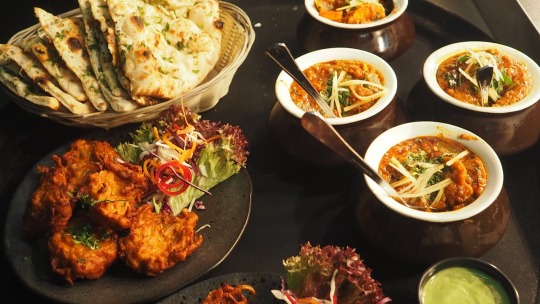
The world is a vast and diverse place, and nowhere is this diversity more evident than in the realm of food. Indian cuisine, with its rich tapestry of flavors and spices, stands as a shining example of culinary excellence. From the fiery heat of a vindaloo curry to the subtle sweetness of a mango lassi, Indian foods offer a sensory experience that is both captivating and unforgettable.
No longer do you have to scour specialty stores or travel long distances to find authentic Indian spices and ingredients. With just a few clicks, you can have everything you need delivered right to your doorstep, allowing you to recreate your favorite Indian dishes with ease and authenticity.
Savoring the Delights of Chinese Cuisine
China, with its vast landscape and diverse regional cuisines, offers a culinary journey that is as varied as it is delicious. From the hearty comfort of Sichuan hot pot to the delicate flavors of Cantonese dim sum, Chinese foods are a celebration of diversity and innovation.
With the rise of online grocery delivery services, exploring the nuances of Chinese cuisine has never been easier. Whether you're in search of the perfect soy sauce for your stir-fry or the essential spices for your favorite noodle dish, supermarkets now offer a wide selection of Chinese ingredients that can be delivered straight to your door, ensuring that you can enjoy authentic Chinese flavors whenever the mood strikes.
Indulging in the Flavors of Arabic Foods
Arabic cuisine is a harmonious blend of flavors and traditions, reflecting the rich tapestry of cultures that have shaped the Middle East over millennia. From the aromatic spices of Moroccan tagines to the sumptuous flavors of Lebanese mezze, Arabic foods offer a gastronomic experience that is both diverse and deeply satisfying.
Supermarkets now offer a wide range of Middle Eastern ingredients and delicacies, allowing you to recreate your favorite dishes at home with ease. Whether you're craving the smoky flavors of a traditional kebab or the fresh taste of a tabbouleh salad, the ingredients you need are just a click away.
Exploring the Spice of Mexican Cuisine
Mexican cuisine is a vibrant and colorful affair, characterized by its bold flavors and fresh ingredients. From the tangy kick of a salsa verde to the rich depth of a mole sauce, Mexican foods are a fiesta for the senses.
Thanks to the convenience of online grocery delivery, exploring the flavors of Mexico has never been easier. Supermarkets now offer a wide range of authentic Mexican ingredients, from dried chilies and spices to tortillas and beans, allowing you to recreate your favorite dishes with ease and authenticity. Whether you're in the mood for tacos, enchiladas, or a classic guacamole, the ingredients you need are just a click away.
Diving into the Romance of Italian Foods
Italy, with its romantic landscapes and rich culinary heritage, offers a gastronomic journey that is as enchanting as it is delicious. From the comforting embrace of a bowl of pasta to the indulgent pleasure of a creamy tiramisu, Italian foods celebrate the art of simple, high-quality ingredients prepared with love and care.
The convenience of online grocery delivery has opened up a world of Italian flavors to food enthusiasts in the UAE. Supermarkets now offer a wide selection of Italian staples, from pasta and olive oil to artisanal cheeses and cured meats, allowing you to create authentic Italian dishes in the comfort of your own home. Whether you're cooking up a family feast or hosting a romantic dinner, the ingredients you need are just a click away.
A World of Flavors Awaits
From the aromatic spices of India to the comforting flavors of Italy, world foods offer a culinary adventure like no other. With the convenience of online grocery delivery, you can easily explore these diverse cuisines without ever leaving your home. So why wait? Embark on a global culinary journey and discover the rich tapestry of flavors that the world has to offer. After all, in the UAE's vibrant melting pot of cultures, every meal is an opportunity to explore, indulge, and celebrate diversity.
#online grocery delivery#grocery#grocery store#arabic food#chinese food#italian food#mexican food#indian food online#indian foods in uae
3 notes
·
View notes
Text
10 Reasons to Visit This Tropical Paradise
Discover Zanzibar
Zanzibar, an archipelago off the coast of Tanzania, is a tropical paradise renowned for its pristine beaches, rich history, and vibrant culture. Known as the "Spice Island," Zanzibar offers an enchanting blend of natural beauty and cultural treasures, making it a must-visit destination for travelers.
1. Pristine Beaches
Zanzibar is famous for its white sandy beaches and crystal-clear turquoise waters. These idyllic beaches are perfect for sunbathing, swimming, and a variety of water sports. Whether you're looking to relax on the shore or dive into adventure, Zanzibar's beaches cater to every preference.
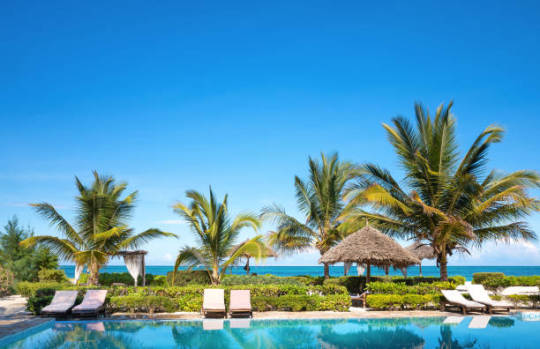
2. Diverse Marine Life
The waters surrounding Zanzibar are teeming with diverse marine life, making it a haven for snorkeling and diving enthusiasts. Explore vibrant coral reefs and encounter dolphins, sea turtles, and exotic fish species in their natural habitat, providing an unforgettable underwater experience.

3. Rich History and Culture
Stone Town, a UNESCO World Heritage Site, is the cultural heart of Zanzibar. Wander through its narrow streets and historic buildings, where a blend of African, Arab, Indian, and European influences is evident in the architecture, cuisine, and traditions. Stone Town's rich history and cultural significance offer a fascinating glimpse into Zanzibar's past.
4. Spice Tours
Zanzibar's nickname, the "Spice Island," is well-deserved. Embark on a spice tour to discover the island's famous spice plantations, where you can learn about and taste cloves, cinnamon, vanilla, and more. These tours provide insight into Zanzibar's spice trade history and its impact on the local culture and economy.

5. Unique Wildlife
Jozani Chwaka Bay National Park is home to the rare red colobus monkey, a species unique to Zanzibar. The park also offers opportunities to see diverse bird species and other wildlife in their natural habitats, making it a great destination for nature lovers and wildlife enthusiasts.
6. Water Activities
For adventure seekers, Zanzibar offers a range of thrilling water activities. Sail along the coast on traditional dhows, try kite surfing and windsurfing, or embark on a deep-sea fishing expedition. The island's coastal waters provide the perfect playground for both relaxation and excitement.

7. Local Cuisine
Zanzibar's cuisine is a delightful fusion of flavors, featuring fresh seafood dishes, tropical fruits, and aromatic spices. Savor traditional Zanzibari dishes like pilau rice, biryani, and seafood curries, and indulge in the island's vibrant food scene.
8. Relaxation and Wellness
Zanzibar's luxurious resorts and spas offer rejuvenating treatments and wellness programs. Enjoy yoga retreats and meditation sessions in serene natural surroundings, providing a perfect escape for those seeking relaxation and wellness.
9. Vibrant Markets
Explore Zanzibar's bustling markets, where you can find local crafts, textiles, and souvenirs. Interact with friendly locals and immerse yourself in the vibrant atmosphere, experiencing the island's lively market culture firsthand.
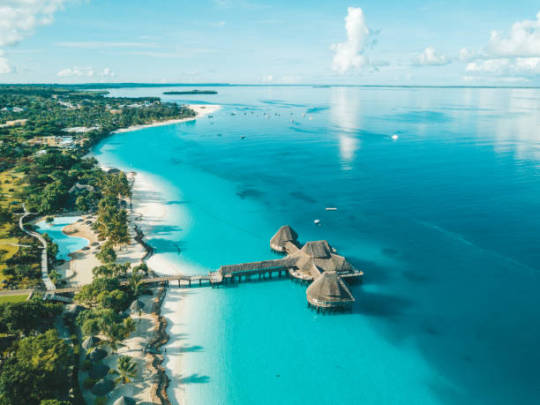
10. Sunset Views
End your day in Zanzibar with spectacular sunsets over the Indian Ocean. The breathtaking views provide a perfect backdrop for relaxation and reflection, offering a serene conclusion to a day of exploration.
Conclusion
Zanzibar is a tropical paradise that offers something for every traveler. From its pristine beaches and diverse marine life to its rich history and vibrant culture,https://plentifuladventures.com/ an unforgettable experience. Whether you're seeking relaxation, adventure, or cultural immersion, Zanzibar invites you to discover its beauty and charm. Plan your visit and experience the magic of this enchanting island destination.

#wild animals#ugandian knuckles#tourism#tourist#tour#the eras tour#Adventure#photography#beach#safari#africa#Nairobi#Uganda#Kenya#Masai Mara#beaches#Wanderlust#east africa#Travel Photography#travel blog#tanzania#tanned#zanzibar#tangled#tanzanite#kenyan#kenya moore#beachlife#Kenya Safari#travel
2 notes
·
View notes
Text
The Sadana Island ship
The Sadana Island ship (Egypt) is of unknown type and origin, it is neither European nor Arabic or any other known Mediterranean type. But an examination of the wood revealed that it date in the 18th century.
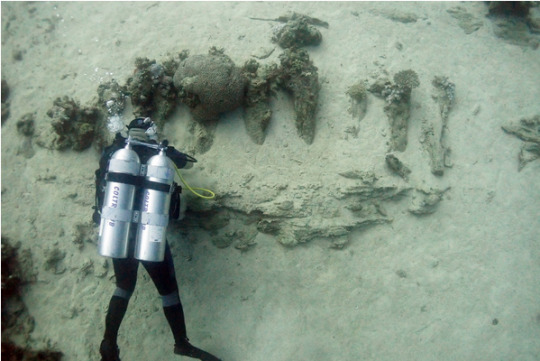
Parts of the wreck (x)
One promising clue comes from historical documents describing Indian ships in the Red Sea.
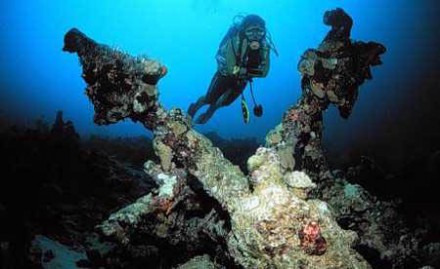
The anchor (x)
So far, no one has found a large Indian ship from the mid-18th century. Egyptian ships from this period have not been found either, so these are two entries on the list of Possible Ship Types.

The Wreck (x)
The ship measures more than 51m in length and was probably at least 15m wide and perhaps as deep. It could have carried up to 900 tonnes of cargo.
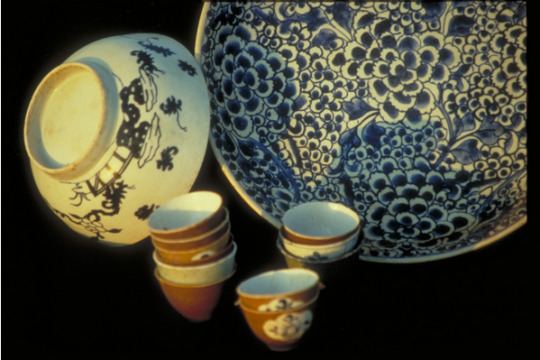
Parts of the cargo (x)
The vast majority of the cargo carried organic material and spices (bharat), including coffee, Indian spices (pepper, coriander, cardamom, and nutmeg), coconuts, hazelnuts, grapes, figs, olives, and remains of sheep, goats, birds, and fish. But also Chinese Qing Dynasty porcelain, large storage jars of clay, and green glass bottles.
61 notes
·
View notes
Text

Okay. So the funniest thing about this whole British people feel like good food is a fantasy thing is it comes from the class structure in their country. So, It used to be that spices were incredibly rare to the point that it's half The reason the British Empire colonised half the world. It was to get their hands on spices. They were purely for the upper class used by the upper class. Now, the problem with colonising half the world to get your hands on spices is that eventually when you get your hands on enough spices the price of spices come down, you also eventually become a multicultural empire and you're inherently not only making the resources more wide spread but also the subjugated workers. So they would ship the subjugated Indian workers to other British colonies, the subjugated African workers to other British colonies, the subjugated Native American workers to other colonies and so on and so forth. So you start spreading a bunch different ethnicities around and having them intermingle, and bring their staple cooking styles with them. And that creates a very unique food culture, where the lower class, who now comprise not just lower class British people but the Indians, Chinese, Africans, Arabs, ect, have access to cheap spices and new cooking techniques because the price of spices is drastically reduced and everyone who isn't aristocracy is kind of merging and intermingling.
So Spices become the thing of the Common Man. spice becomes available to the working masses. Suddenly salt and pepper aren't a luxury. They are a goddamn Necessity. cinnamon, cumin, everything becomes a goddamn necessity and you get people spreading spicy flavorful food amongst the working class. So when the British upper crust, especially during the Georgian and Victorian era saw that this was happening. They were like,” oh, oh God. I don't want to eat spices anymore because the working poor man is eating spices. So instead We're going to focus on traditional British only meals from now on”. Now the funny thing about traditional British only meals is that they're very fucking plain because for the majority of their history as a fucking island nation, the people who really dictate a national identity, the working class, haven't had access to the resources that make food flavorful.
So they've been relying on very meaty plan, flavours, oniony kind of flavours ect. The kind you get out of boiling , mashing, stewing and reducing the shit out of your ingredients. Maybe they would have salt maybe. But mostly it's The flavours that you get out of the actual food itself instead of the things like spices and herbs that you add to food to make it flavorful. So the upper crust played themselves, started eating very Bland, very flavorless food, and insisted that this was the real traditional British cuisine ,and that created the idea that British cooking is Boring, right?
And then you add on to that World War II, where everyone else is now forced to eat. Bland flavorless food because of rationing and Suddenly you've got an entire fucking culture, whose food has had to take a massive back seat, but we're also talking about the same culture that when it rebounded because where things like… I think it's tikka masala and a bunch of other like Multicultural style dishes originate. And that comes from its multicultural background. so British cooking can be quite flavorful. It can be quite good but the British Aristocracy, of which Tolkien was a part of, Viewed food with flavour as being of the lower class and it's fucking hilarious. So that's why the hobbits and dwarves, who are written as lower class allegories, have amazing flavourful food, because for the most part so did the British lower class. And its why the elves have this bland shit like … nimbus bread? That tastes like sawdust but can keep you fed for an entire day on a single bite.
#tolkin#lord of the rings#british food#rich people being idiot#excuse the strange punctuation#i used my phones recorder app to make a transcript and it got WILD with rhe grammer#its hilarious#but so is the stupidity of the British aristocracy#good lord they are some gammon whitefellas
2 notes
·
View notes
Note
Sorry to correct you but. Samosa is an indian dish not Kenyan
Hello anon! LOL okay I never expected to get into Samosa Discourse on my Star Trek blog but I happen to love food and history and the history of food so here we go😂
You are correct that samosas are not native to Kenya- and yes, India is by far the country most associated with samosas in the popular imagination (for good reason, samosas are pretty much omnipresent throughout India!) But while samosas are not originally from Kenya, that doesn't mean (imo at least) that they cannot be counted as part of Kenyan cuisine. (Which I didn't even necessarily do in that post, but I understand your position so I'll elaborate on those terms!)
Kenya is a multi-ethic country made up of several African peoples and migrant communities, including Kenyan Asians. Now, the history of South Asians living in/trading with East Africa goes back centuries, but there was also this huge (and deeply colonial) boom in the Asian population during the late 1800s-early 1900s when the British sent tens of thousands of indentured Indian labourers to Kenya to build the Uganda railway. (There is a LOT more history I could get into re the British East Africa Protectorate and the complicated social dynamics between African & Asian communities at the time, but that's not really relevant to samosas so I'll spare you.)
Anyway, modern day Kenya still has a considerable South Asian population, and as such (again not getting into the more complicated social dynamics here), Kenyan cuisine has a lot of Indian (and Arab) influences. But beyond that- Swahili culture(s) and cuisine(s) evolved over centuries of interaction between the various (predominantly Bantu) peoples of East Africa and traders from West, Central & South Asia (who brought in- among other things- their own spices), so cultural intermingling has always been a staple of the East African coast (which is geographically SO close to Asia!) If you were to walk around some of the bigger, more Asian diaspora-heavy cities of Kenya, like Mombasa or Nairobi, you'd find plenty of chicken/fish-based coconut curries & stews that strongly resemble Indian ones- as well as rice-based dishes like pilau & biriyani, rotis, chapatis, bhajias (called 'bajjis' in certain parts of India), kheemas, kebabs- and yes, samosas. Or sambusas, as they're often called in Kenya.
And what's more- the samosa (originally 'samsa' iirc) likely originated in Central Asia in the first place! It still goes by other names in West Asia and North Africa too; as do several other dishes-in-common. In fact, kuku paka (a dish I mentioned in the post that prompted this ask) is a Kenyan chicken curry with distinct Indian & Arabic influences. So if samosas can qualify as Indian cuisine (which, they undoubtedly do), imo they can qualify as a part of Kenyan cuisine too! Anyway I'm truly sorry I let this ask get SO far away from me lmao, I guess I've always felt a bit alienated by this growing tendency in Asian & African communities to sort of rigidly and unquestioningly (even proudly) uphold colonial divides when our cultures are actually so sprawling and ancient? Like sure, we are not monoliths, and it is important that people learn that- but also, so many political borders across both continents didn't even exist as they are today even a hundred years ago. It's so cool how much there is in common! Food, like so many other aspects of culture, is often migratory and full of varied influences, and that's just so deeply human and beautiful and fascinating to me
#nebulouscoffee on tumblr: come for the trekposting stay for the samosa lore apparently? lol#apologies to anyone who actually read all this rambly nonsense wish I could give you a sambusa/samosa as a reward#also anon I know you meant well and TRULY no hard feelings so pls don't take this the wrong way but. this ask made me giggle#I don't know if you're indian or just a concerned (white) citizen but speculating actually cheered me up on a Trying night so thank you!#in either case: you needn't worry!! I'm not out here on a mission to spread samosa misinformation on my star trek blog peace and loveee#(in all seriousness I'm very sorry if this reply came off as condescending or dismissive I promise it wasn't at all meant that way)#((might delete later btw just putting that out there))
15 notes
·
View notes
Photo

Portuguese Cochin
Cochin, located on the southwest coast of India, was a Portuguese colony from 1503 to 1663. Known to the Portuguese as Cochim, it was one of several important cities on India’s Malabar Coast and a great trade centre for spices like pepper. Cochin was the administrative capital of Portuguese India until it was replaced by Goa in 1530.
A fort was built at Cochin in 1503, the first in Portuguese India, as the Europeans used the city as their first headquarters in the East. The great explorer Vasco da Gama (c. 1469-1524) spent his last days in the city, and it remained a lucrative hub of the spice trade into the 17th century. The city was taken over by the Dutch in 1663, then the English in 1814, and finally gained independence with the rest of India in 1947. Today, the city is known as Kochi and is the most prosperous port in the Kerala region of India.
Vasco da Gama
In the 15th century, the Portuguese colonization of Madeira in the North Atlantic from 1420 was the first in a series of colonial stepping stones that eventually led to India. The treacherous Cape Bojador in West Africa was negotiated in 1434, the Azores were colonised from 1439, Cape Verde from 1462, and São Tomé and Principe from 1486. In 1488 Bartolomeu Dias sailed down the coast of West Africa and made the first voyage around the Cape of Good Hope, the southern tip of the African continent (now South Africa).
The famed Portuguese explorer Vasco da Gama followed in Dias’ wake and pioneered a maritime route from Portugal to India when in 1497-9, he sailed around the Cape of Good Hope, went up the coast of East Africa, and crossed the Indian Ocean to arrive at Calicut (now Kozhikode) on the south-west coast of India. His voyage, supported by King Manuel I of Portugal (r. 1495-1521), was intended to find a legendary Christian kingdom in the East and to give Portugal direct access to the Eastern spice trade and cut out the Arab middlemen traders. The first aim ended up being an illusion but the second was indeed achieved. For the first time, Europe could access by sea a trade which had been going on for centuries but which channelled luxury goods through the Red Sea and the Persian Gulf to be then taken by camel caravan to the Mediterranean. Such goods as pepper, ginger, cloves, and cinnamon were immensely popular in Europe and expensive.
Vasco da Gama, through a mix of inexperience, lack of trade goods, and Indian confidence in the status quo, failed to establish friendly trading relations with Calicut. A second Portuguese expedition, this time with 13 ships and 1500 men and commanded by Pedro Álvares Cabral, set off to repeat da Gama’s feat in March 1500 and was given the brief of muscling-in on Muslim trade by sinking any Arab ships they came across. Vasco da Gama sailed for a second time to India in 1502-3, this time with 15 ships. A result of this voyage was more trouble with the ruler of Calicut, but a trade treaty was agreed with Cochin further down the coast.
Continue reading...
17 notes
·
View notes
Text

🦇 Fatima Tate Takes the Cake Book Review 🦇
❝ Is it haram to follow your dreams? ❞
❓ #QOTD Did you turn your childhood dreams into a reality, and if not, what stopped you? ❓
🦇 Growing up in a traditional Muslim household, seventeen-year-old Fatima Tate is used to living a life that adheres to her parents' wishes. They see her passion for baking as a hobby, even though Fatima hopes to win a state baking competition hosted by the Culinary Institute of America; the college she hopes to attend despite her mother's desire for her to major in nursing. Her parents would freak out if they knew she was flirting with college student Raheem, who also volunteers at the local soup kitchen with Fatima. Their secret flirting by text heats to a simmer until their parents are involved. Eager to give their daughter a happy, stable life, Fatima's parents encourage their engagement. It's not until the ring is on her finger that Fatima realizes the happily ever after Raheem is offering comes at a price.
💜 Growing up in a traditional Muslim household myself, I hoped Fatima's story would defy some of the stereotypes too often placed on the religion, traditions, and culture. Every coming-of-age / YA story positions readers at a pivotal turning point in a character's life. For Muslim characters, that turning point feels pre-defined by the expectations elders place on us. Fatima does, eventually, define her own path, but after trying to earn her parents' approval and understanding for the entire novel, it feels too instantaneous by the end (especially given her mother's consistent stance about Fatima's future from the start).
🍰 Many baking-focused books published in the last year—books like Rubi Ramos's Recipe for Success, Recipe for Persuasion, or Arsenic and Adobo with talented Cuban, Indian, and Filipino main characters—bring flare and flavor to their novels by focusing on culture through food. Reading these books, you can smell distinct spices fill the air, taste every kick of cinnamon, clove, or coriander against your tongue. Every food-focused page makes you salivate until you wish you had the very dishes and sweet treats mentioned before you. I was so eager to see familiar Middle Eastern flavors and dishes highlighted in this novel, to see Fatima complete the step-by-step process of making treats with orange blossom water, phyllo dough, cinnamon, or rose water, but none were mentioned. The beauty of the books I mentioned above was the chance to connect with someone else's culture through food, but I fear non-Middle Eastern readers missed that chance with this story. Instead, the cooking scenes sound clinical, like reading out the instructions of a recipe step-by-step. For a character who claims baking is her everything, she's not at all passionate about the art.
🎂 That's hardly the biggest problem. Growing up as a Muslim-American in a strict, traditional household, I understood everything that Fatima experienced; following rules and traditions, not wanting to "make trouble," not wanting to disappoint my parents, feeling the pressure to meet their standards. (Like Fatima's best friend, I'm also Muslim and queer, which comes with its own challenges.) Despite growing up in the same circumstances, I couldn't connect to Fatima beyond that surface level. The story starts with her crushing on a boy, but she's so instantly blinded by him—despite all the immediate red flags popping up—that we don't see a version of Fatima that's level-headed. Instead, we exist in her ongoing, anxious mindset—anxious about a boy, hiding her feelings for him, displeasing her parents, her family's financial situation, all of it. There's so much focus on those sources of anxiety and on Raheem's wrong-doings that we never get to see the beauty Islam has to offer. For the sake of non-Muslim readers, I also wish a few Arabic terms were explained at the story's start.
☪️ A book that could have proven the worst misconceptions about Islam wrong only made those misconceptions worse. Fatima views religious customs as "ancient" impositions that make it seem she's shackled to old ways, yet she made the choice to wear a hajib (a choice no one else can make for her). She prays alone in her room instead of with her family, doesn't seem to attend mosque, and notes how "patriarchal" the local masjid is. Readers are given two extremes of Islam: the overly traditional "haram police" or Fatima, who seems to wear her religion as an obligation or facade, rather than as a faith that unites her with a beloved community. There's no positive Muslim representation at all in this book—a book that aimed to give "a much-needed voice to young Black Muslim women." I agree; those voices need to be heard. Muslim voices need to be heard. But not like this. I'm not only disappointed. I'm hurt.
🦇 Recommended to anyone who loves a semi-food-focused YA coming-of-age story with an insta-love connection.
☪️ Muslim Representation / OWN Voices
🍰 Great British Bake Off Vibes
🎂 Contemporary/YA Fiction
🧁 Queer Minor Characters
☪️ A Junior Library Guild Gold Standard Selection
🦇 Major thanks to the author and publisher for providing an ARC of this book via Netgalley. 🥰 This does not affect my opinion regarding the book.
#book review#book blog#booklr#books#book thoughts#book: fatima tate takes the cake#author: khadijah vanbrakle#batty about books#battyaboutbooks
5 notes
·
View notes